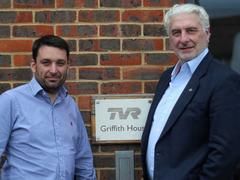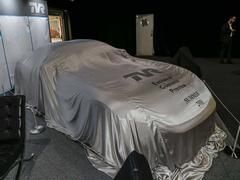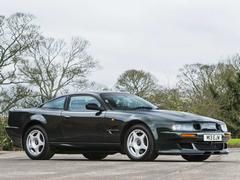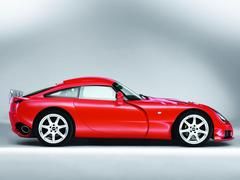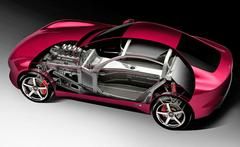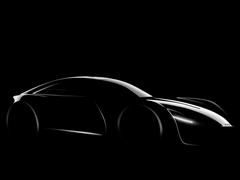New TVR - the car
We've been chatting with Les Edgar; full interview to follow but here's the latest on the car

The basics first, many of which we already know. It's a classic rear-driven coupe with a traditional layout of a front-mounted, normally-aspirated 5.0-litre V8 engine, sourced from the Ford Mustang but dry sumped, fitted with a lightweight flywheel and fully retuned to suit TVR's needs by Cosworth. No power or performance figures are so far quoted but Edgar says the basic design target is 400hp per tonne; given he's said the car will weigh around 1,200kg it doesn't take a maths genius to figure out that equates to around 500hp. In our interview Edgar also confirmed it will be offered in at least two states of tune, indicating Cosworth has found considerable extra headroom while calibrating the power delivery for a vehicle half a tonne lighter than the Mustang it was originally developed to power.
Even fitted to a Mustang test mule - we were shown footage of the car running at Bruntingthorpe - Edgar describes the V8 as "a f***ing animal", which will please those hoping new TVR hasn't forgotten old TVR's capacity for hairy-chested thrills. Edgar's personal taste for brawny Aston Martins - alongside various TVRs - extends to the monstrous, twin supercharged Vantage V600. Taking that into account when he says the new TVR must be "unapologetic", it's reasonably safe to assume this car won't be a shrinking violet. Even if the styling buck seems reluctant to emerge from under its sheet for now.
The manual gearbox is conventionally located, rather than in a transaxle. "It would have helped us a lot with our weight distribution," admits Edgar, "but it's expensive and we've managed to conquer that elsewhere." Although he doesn't rule out a paddle-shifted auto of some sort at some point in the future the new TVR was always going to be a manual first and foremost. "Yes you are going to lose half a second 0-60 but that's not what it's about," he says.
Now the tricky bit....
Getting Cosworth to tune up a crate V8 and extrapolating performance characteristics from a projected kerb weight isn't that hard, relatively speaking. At which point we introduce Gordon Murray and his much discussed iStream production system.
In reply to a question from PHer Smilo996 about how much this saves the answer would appear to be as much as 80 per cent, both in factory set-up and actual production costs. You can read up on iStream on the dedicated website but the basic gist is clever use of materials, streamlined production techniques and the dedication to stiffness, strength and weight-saving you'd expect from someone of Murray's background. From what Edgar and Chasey say iStream is key to them being able to deliver on both performance and price goals.
In its basic form simple spaceframes - initially from suppliers, later to be built in-house - exploit steel's proven abilities to both dissipate shocks and provide hard points for suspension, seats, subframes and the like. Triangulation traditionally provided by a lattice of smaller tubes instead comes from bonded in composite panels or - in the case of TVR's Launch Edition car - carbon fibre honeycomb. The decision to go for the latter was, says Edgar, a major one.
Murray's respect for the original Smart is reflected in a similar construction; the composite panels are not structural and quickly and easily fitted mechanically at the final stage of production, speeding up assembly and meaning the car is mechanically complete before taking shape aesthetically. This also means flexibility to offer different body styles, future model variants or different materials all based around the same platform.
As already confirmed motorsport is also part of the plan, with a separate development team looking at ways to adapt the car to endurance racing. "Beating the Astons would be lovely," beams Edgar. Although most of the design hardpoints were set 18 months ago feedback from this side has influenced the road car, not least with an increase in 50mm to the track and some other modifications that, in Chasey's words, "make a big difference to the race car without compromising the road version."
Currently comprising just a dozen staff in addition to Edgar and Chasey, TVR's ability to draw on the skills of the 150-strong team at Gordon Murray Design should help with the fiddly stuff like seals, hinges and other details often the downfall of similar cars. "I think we can safely say this is the most amount of design time of any TVR ever, the most tested TVR ever, by orders of magnitude," laughs John.
"It's curvy, it's beautiful"
Homologation to EU rules for production runs of fewer than 2,000 per year offers a sense of the upper limit of potential TVR production and gives latitude to live true to the brand's traditional values of minimal nannying. It will have airbags and (switchable) ABS, plus a minimalist take on the kind of in-car gadgetry modern drivers expect. But it's safe to say it won't be an Audi-rivalling 'virtual cockpit', Edgar admitting that "we won't be able to go bespoke but we will make sensible decisions and it will be properly integrated into the car." For all the minimalism there will be a degree of opulence, in keeping with previous TVR cabins. "One of the things I love about my Sag when I get into it is I feel surrounded by it," says Les. "It's curvy it's beautiful - every part of the outside is curvy and beautiful - and bonkers - but the inside of it reflects that. And I love that about the Wheeler era TVRs."
The first 500 cars will be known as Launch Edition models with a full aero package, the higher state of tune from the V8, the carbon fibre iStream chassis, the option of a unique paint colour and, as Edgar has it, "my undying gratitude" for those who've put their money where their mouths are. Customers will see it later this year and there will be a formal unveiling early next year; this is likely to be a standalone event and TVR in flavour rather than at a major motor show like Geneva.
How much money will these buyers have to cough up? The standard car that follows will apparently pick up where Sagaris pricing left off and in the realms of, as Edgar has it "souped up Caymans" like the GT4, meaning at least £60K. Edgar rightly identifies pricing as a "hot topic" but is unapologetic at the Launch Edition costing significantly more than this, promising a "sensational experience" for the early adopters and addition of a particularly special feature he's not willing to discuss at this point. Commence speculation here about what that might entail...
TVR the rebirth sketch time lapse
Aston Martin V600 picture courtesy of Bonhams
[Sources: Gordon Murray Design, iStream, Cosworth]
Gassing Station | General Gassing | Top of Page | What's New | My Stuff

